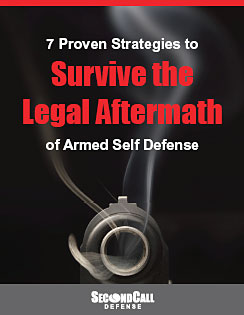Bad News: Some criminals may have more firearms training than you
In a recent article on the Buckeye Firearms Association website, Greg Ellifritz cited some startling findings from a 2006 FBI study on violent criminals.
Titled
Violent Encounters: A Study of Felonious Assaults on Our Nation’s Law Enforcement Officers, the study looks at the difference between officers and the criminals who assault them.
According to the study, 40% of the criminal attackers received formal firearms training, over 80% regularly practiced with firearms (averaging 23 practice sessions a year),
more than 40% had at least one gunfight experience, and 25% had been involved in more than 5 gunfights.
If you’re like most people, you operate under the popular assumption that bad guys don’t have any firearms training and don’t practice shooting. It’s a comforting thought, because it suggests that as long as you’re armed and have a little training, you stand a pretty good chance of surviving a violent attack.
However, the data in this report suggests that may not always be the case.
Here are some other facts presented in the study:
- The offenders were exposed to more violence at an earlier age.
- They are more willing and able to use force, including deadly force.
- Most are younger and less educated, but obviously have street smarts from their experiences (especially what they learn in jail from other offenders).
- Gang members in particular learn “violent values” at an early age and these values are regularly reinforced.
- The goal for gang members is to achieve status and respect from their peers, which comes from creating fear through repeated acts of physical violence.
- Their behavior is not constrained by social, legal, or ethical considerations.
You can download the study and read it yourself. But here are some things to consider.
It’s a mistake to assume that bad guys are untrained. It’s true that this study on violent attacks on law enforcement officers may not be representative of all violent offenders. However, it does show that some portion of the most violent people in our society take crime seriously.
Just as you may own or carry a firearm “just in case” you are faced with life-threatening violence, you should apply the same “just in case” thinking to who your attacker might be. They might be someone with more training and more willingness to do harm. They may be someone who has actual gun fighting experience and won’t suffer the same level of disorientation as you will when bullets start flying. They may also be faster to escalate to a level of lethal force.
What does this mean for you? It means, a physical threat may not be the “make-my-day” scenario you’ve been seeing in your mind when you train. It could be more violent than you imagine. And your range practice, standing in a lane calmly shooting paper targets, may prove irrelevant when you’re being tackled to the ground, slashed at with a knife, or shot by a well-armed and willing attacker.
It also means, you should seek out training that goes beyond a basic concealed carry class. Do you practice an average of 23 times a year as does the average subject in this study? Probably not. Frequent and ongoing training could help you improve your chances of survival.
Second Call Defense is not a firearms training organization. We focus on protecting our members legally after they’ve survived a lethal-force encounter. However, one of the best ways to avoid legal trouble is to be highly trained and fully competent with a firearm. The more training you have, the more confidence you’ll have. And the more confidence you have, the more likely you are to avoid unnecessary violent encounters and to respond quickly, appropriately, and effectively to violence when it happens.
Whether you encounter a dumb thug who isn’t expecting you to fight back or a career criminal with a lot of training and experience may be a matter of luck. But as they say, luck favors the prepared.
“

